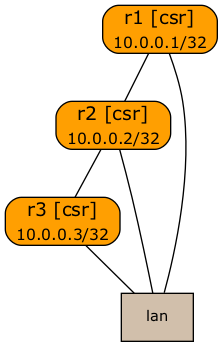Running IS-IS over Unnumbered Ethernet Interfaces
Last time we figured out that we cannot run OSPF over unnumbered interfaces that are not point-to-point links because OSPF makes assumptions about interface IP addresses. IS-IS makes no such assumptions; IPv4 and IPv6 prefixes are just a bunch of TLVs exchanged between routers over a dedicated layer-3 protocol with ridiculously long network addresses.
Could we thus build a totally unnumbered IP network with IS-IS even when the network contains multi-access segments? It depends:
- It works like a charm on Arista EOS and Cisco IOS XE.
- Cisco NXOS has a few quirks.
- Junos vSRX works well with unnumbered IPv4 P2P links. IPv6 works like a charm (no surprise there due to link-local addresses).
We’ll use the following lab topology to run our tests. All devices run the same network operating system. All physical interfaces are unnumbered – the only IP addresses in the lab are assigned to loopback interfaces. P2P links have cost 10, the LAN link has cost 5.

Lab topology
Once I fixed the IS-IS network type (point-to-point network type should be used on P2P links but not on multi-access links), the adjacencies came up almost immediately (Gi3 is the multi-access interface):
r1#show isis neighbors
Tag Gandalf:
System Id Type Interface IP Address State Holdtime Circuit Id
r2 L2 Gi2 10.0.0.2 UP 23 02
r2 L2 Gi3 10.0.0.2 UP 21 r3.01
r3 L2 Gi3 10.0.0.3 UP 8 r3.01
The IS-IS database has a pseudonode LSP (r3.01-00) confirming that one link in the topology works as a multi-access link:
r1#show isis database
Tag Gandalf:
IS-IS Level-2 Link State Database:
LSPID LSP Seq Num LSP Checksum LSP Holdtime/Rcvd ATT/P/OL
r1.00-00 * 0x00000006 0x1A38 1009/* 0/0/0
r2.00-00 0x00000006 0x8499 1006/1200 0/0/0
r3.00-00 0x00000006 0x4DF8 1006/1197 0/0/0
r3.01-00 0x00000002 0xDCDC 1007/1199 0/0/0
All three routers are connected to the pseudonode LSP:
r1#show isis database r3.01-00 detail
Tag Gandalf:
IS-IS Level-2 LSP r3.01-00
LSPID LSP Seq Num LSP Checksum LSP Holdtime/Rcvd ATT/P/OL
r3.01-00 0x00000002 0xDCDC 987/1199 0/0/0
Metric: 0 IS-Extended r3.00
Metric: 0 IS-Extended r1.00
Metric: 0 IS-Extended r2.00
Mission accomplished. We got our network up and running over unnumbered interfaces.
Not so fast. Does IP routing work? Let’s inspect the IP routing table:
r1#show ip route | begin Gateway
Gateway of last resort is 192.168.121.1 to network 0.0.0.0
S* 0.0.0.0/0 [254/0] via 192.168.121.1
10.0.0.0/32 is subnetted, 3 subnets
C 10.0.0.1 is directly connected, Loopback0
i L2 10.0.0.2 [115/15] via 10.0.0.2, 00:17:05, GigabitEthernet3
i L2 10.0.0.3 [115/15] via 10.0.0.3, 00:16:39, GigabitEthernet3
Looks good. Loopback interfaces of other routers are reachable over GigabitEthernet3… but the next hop is the loopback IP address itself, so we need some ARP glue (more details). Do we have it?
r1#show arp 10.0.0.0 255.0.0.0
Protocol Address Age (min) Hardware Addr Type Interface
Internet 10.0.0.1 - 5254.00ff.e287 ARPA GigabitEthernet2
Internet 10.0.0.1 - 5254.00d3.58b7 ARPA GigabitEthernet3
Internet 10.0.0.2 20 5254.00b1.edb0 ARPA GigabitEthernet2
Internet 10.0.0.2 18 5254.00d9.55ec ARPA GigabitEthernet3
Internet 10.0.0.3 18 5254.007d.f1e5 ARPA GigabitEthernet3
All the expected ARP glue entries are there. The final test: pinging remote loopback.
r1#ping r3
Type escape sequence to abort.
Sending 5, 100-byte ICMP Echos to 10.0.0.3, timeout is 2 seconds:
!!!!!
Success rate is 100 percent (5/5), round-trip min/avg/max = 1/1/1 ms
OK, now we know it works 👍
Long story short: use IS-IS 😁
Next: BGP Unnumbered Duct Tape Continue
Addendum: NXOS Quirks
Cisco NXOS is different. Not only does it need an incredible amount of time to boot, it doesn’t like multi-access unnumbered IPv4 links… but you can still persuade it to use them (sort of).
Here’s the full story:
- To use ip unnumbered on NXOS you have to configure medium p2p
- medium p2p seems to trigger point-to-point IS-IS links. With three NXOS switches connected to the same segment (R1, R2 and R3 are connected to Ethernet1/2) you get all the expected IS-IS adjacencies:
r1# show isis adjacency
IS-IS process: Gandalf VRF: default
IS-IS adjacency database:
Legend: '!': No AF level connectivity in given topology
System ID SNPA Level State Hold Time Interface
r2 N/A 2 UP 00:00:31 Ethernet1/1
r2 N/A 2 UP 00:00:23 Ethernet1/2
r3 N/A 2 UP 00:00:23 Ethernet1/2
However, the IS-IS topology database does not contain the pseudonode LSP:
r1# show isis database
IS-IS Process: Gandalf LSP database VRF: default
IS-IS Level-1 Link State Database
LSPID Seq Number Checksum Lifetime A/P/O/T
IS-IS Level-2 Link State Database
LSPID Seq Number Checksum Lifetime A/P/O/T
r1.00-00 * 0x00000009 0x1E07 967 0/0/0/3
r2.00-00 0x00000009 0x72FD 1181 0/0/0/3
r3.00-00 0x00000007 0xC0F9 1153 0/0/0/3
Also, the LSP generated by R1 contains P2P links to R2 and R3 instead of a link to the pseudonode LSP:
r1# show isis database detail r1.00-00
IS-IS Process: Gandalf LSP database VRF: default
IS-IS Level-1 Link State Database
LSPID Seq Number Checksum Lifetime A/P/O/T
IS-IS Level-2 Link State Database
LSPID Seq Number Checksum Lifetime A/P/O/T
r1.00-00 * 0x00000009 0x1E07 921 0/0/0/3
Instance : 0x00000009
Area Address : 49.0001
NLPID : 0xCC 0x8E
Router ID : 10.0.0.1
IP Address : 10.0.0.1
MT TopoId : TopoId:2 Att: 0 Ol: 0
TopoId:0 Att: 0 Ol: 0
Hostname : r1 Length : 2
TopoId: 2
MtExtend IS : r3.00 Metric : 5
r2.00 Metric : 5
r2.00 Metric : 10
Extended IS : r2.00 Metric : 5
Extended IS : r3.00 Metric : 5
Extended IS : r2.00 Metric : 10
Extended IP : 10.0.0.1/32 Metric : 1 (U)
MT-IPv6 Prefx : TopoId : 2
2001:db8:1:1::/64 Metric : 1 (U/I)
Digest Offset : 0
While a network of Nexus switches works as expected, I wouldn’t expect a multi-vendor segment to work as everyone else insists on a different view of the world.

this sure makes a ring topology deployment easy
FRRouting (Linux) with pure IS-IS, the only way it currently (10.3) works is to copy the loopback IPv4 address to the interfaces that you need to do IPv4 routing on. The OpenFabric (IS-IS "extension" draft) does support true unnumbered interfaces and route the IPv6.